Exchange Currency
Nicaraguan cordoba
The córdoba is the currency of Nicaragua. It is divided into 100 centavos.
Spanish Escudo (XESE) coins were used in Nicaragua while it was part of the Viceroyalty of New Spain with 1 Escudo divisible into 2 Pesos or 16 Reales. The Central American Escudo/Peso (XCAE) was used while Nicaragua was part of the Central American Federation. After gaining its independence, Nicaragua issued the silver Peso (NIP), at par with the Central American Peso, and divisible into 8 Reales. Nicaragua linked the Peso to the French Franc in 1870 with 1 Peso equal to 5 French Francs and divisible into 100 Centavos.
Nicaragua has never minted its own coins domestically. All coins have been minted in the US or the UK. Nicaraguas first coins were issued in 1878. In the early 1900s, Nicaragua was split into two currency areas, with gold and silver being used on the Atlantic side, in Cabo and Zelaya, while paper money predominated in the west.
Nicaragua unified its currency by introducing the Gold Cordoba (NIG) on March 20, 1912 with 1 Gold Cordoba equal to 12.5 Pesos. Nicaragua left the Gold Standard on November 13, 1931. Nicaragua suffered severe inflation under the Sandinistas. The Nicaragua New Cordoba (Chanchero) replaced the Gold Cordoba on February 15, 1988 at the rate of 1 Cordoba equal to 1000 Gold Cordobas. The Cordoba Oro replaced by the Cordoba on April 30, 1991 at the rate of 1 Cordoba Oro equal to 5,000,000 Cordobas.
The Government of Nicaragua issued banknotes until March 20, 1912 when the Banco Nacional de Nicaragua was established and the Cordoba was introduced. The Banco Central de Nicaragua replaced the Banco Nacional in 1961 as the sole note issuing authority.
On February 15, 1988, the 2nd córdoba was introduced. It was equal to 1000 1st córdobas. On April 30, 1991 the third córdoba, also called the córdoba oro, was introduced, worth 5,000,000 2nd córdobas. As of September 6th, 2012; 24.53 cordobas are equal to one US dollar.
In 1939, cupro-nickel replaced silver on the 10, 25 & 50 centavos. In 1943, a single year issue of brass 1, 5, 10 & 25 centavos was made. These were the last 1 centavo coins. In 1972, cupro-nickel 1 córdoba coins were issued, followed, in 1974, by aluminium 5 and 10 centavos.
A new series of coins, featuring a portrait of Augusto César Sandino, was introduced in 1981, consisting of aluminum 5 & 10 centavos, nickel-clad steel 25 centavos & cupro-nickel 50 centavos, 1 & 5 córdobas. Nickel clad steel replaced cupro nickel between 1983 and 1984. In 1987, the final coins of the 1st córdoba were issued, featuring Sandino's characteristic hat. Aluminum 5, 10 & 25 centavos and aluminium-bronze 50 centavos, 1 & 5 córdobas were issued, together with aluminium 500 córdobas.
25 centavos,50 centavos & 1 córdoba minted in 1985 were mostly recalled and destroyed by central bank. a few of 1 cordoba were circulated as seen.
In 1994, coins were issued in denominations of 5, 10, 25 & 50 centavos. All were minted in chrome-plated steel. In 1997, nickel-clad steel 50 centavos, 1 & 5 córdobas were introduced, followed by copper-plated steel 5 centavos & brass-plated steel 10 & 25 centavos in 2002 & brass-plated steel 10 cordobas in 2007.
All current coins have the coat of arms of the country on the obverse and the numeral of the denomination on the reverse.
In 1962, the Central Bank of Nicaragua took over paper money issuance. The 1 córdoba notes were replaced by coins in 1972. After 5 córdobas coins were introduced in 1981, 2 and 5 córdobas notes were withdrawn. In 1987, 5000 córdobas notes were introduced, followed by overprinted 10,000 (on 10), 20,000 (on 20), 50,000 (on 50), 100,000 (on 100), 100,000 (on 500), 200,000 (on 1,000), 500,000 (on 20), 500,000 (on 1,000) and 1,000,000 (on 1,000) córdobas notes as inflation drastically reduced the córdoba's value.
The second córdoba was only issued in banknote form. Notes (dated 1985) were issued in 1988 in denominations of 10, 20, 50, 100, 500 and 1000 córdobas together with undated 5000 córdobas. In 1989, notes for 20,000 and 50,000 córdobas were introduced, followed the next year by 5 million and 10 million córdobas notes.
In 1991, notes were introduced for 1, 5, 10 and 25 centavos, ½, 1, 5, 10, 20, 50 and 100 córdobas. The notes below 1 córdoba were replaced by coins in 1994, with 5 córdobas notes also being replaced in 1997. 500 córdobas notes were introduced in 2002.
Famous people from Nicaragua's history are depicted on the obverses of the current banknotes. The reverses depict landmarks or natural habitats in the country.
On May 15, 2009, polymer ten and twenty córdoba notes were issued to replace their paper counterparts. A new polymer two hundred and a paper one hundred córdoba banknote was first issued on June 1, 2009. A new polymer 50 córdoba was issued on December 3, 2009. The new designed paper 500 córdoba banknote was introduced on January 12, 2010. A commemorative design of the 50 córdobas was introduced on September 15, 2010.
Summary info
Summary information about Nicaraguan córdoba- ISO 4217 Code:
- NIO
- Currency sign:
- C$
- Country:
- Nicaragua
- Subunit:
- centavo
- Coins:
- 5 centavos, 10 centavos, 25 centavos, 50 centavos, 1 córdoba, 5 córdobas
- Banknotes:
- 10 córdobas, 20 córdobas, 50 córdobas, 100 córdobas, 200 córdobas, 500 córdobas
- Central bank:
- Central Bank of Nicaragua
History
Although Christopher Columbus sighted the coast of Nicaragua in 1502, Gonzales Davila and his fellow conquistadores were the first Spaniards to step foot on Nicaragua in 1522. The provinces of Leon and Granada were part of the Viceroyalty of New Spain before becoming part of the Central American Republic in April 1823. On April 17, 1825, the two provinces were merged to create Nicaragua. Nicaragua remained a constituent state of the Central American Republic until April 30, 1838 when it declared its independence. The eastern coast of Nicaragua was a British protectorate affectionately called the Mosquito Kingdom, but in 1850 the coast was ceded to Nicaragua while confirming British possession of British Honduras.Spanish Escudo (XESE) coins were used in Nicaragua while it was part of the Viceroyalty of New Spain with 1 Escudo divisible into 2 Pesos or 16 Reales. The Central American Escudo/Peso (XCAE) was used while Nicaragua was part of the Central American Federation. After gaining its independence, Nicaragua issued the silver Peso (NIP), at par with the Central American Peso, and divisible into 8 Reales. Nicaragua linked the Peso to the French Franc in 1870 with 1 Peso equal to 5 French Francs and divisible into 100 Centavos.
Nicaragua has never minted its own coins domestically. All coins have been minted in the US or the UK. Nicaraguas first coins were issued in 1878. In the early 1900s, Nicaragua was split into two currency areas, with gold and silver being used on the Atlantic side, in Cabo and Zelaya, while paper money predominated in the west.
Nicaragua unified its currency by introducing the Gold Cordoba (NIG) on March 20, 1912 with 1 Gold Cordoba equal to 12.5 Pesos. Nicaragua left the Gold Standard on November 13, 1931. Nicaragua suffered severe inflation under the Sandinistas. The Nicaragua New Cordoba (Chanchero) replaced the Gold Cordoba on February 15, 1988 at the rate of 1 Cordoba equal to 1000 Gold Cordobas. The Cordoba Oro replaced by the Cordoba on April 30, 1991 at the rate of 1 Cordoba Oro equal to 5,000,000 Cordobas.
The Government of Nicaragua issued banknotes until March 20, 1912 when the Banco Nacional de Nicaragua was established and the Cordoba was introduced. The Banco Central de Nicaragua replaced the Banco Nacional in 1961 as the sole note issuing authority.
On February 15, 1988, the 2nd córdoba was introduced. It was equal to 1000 1st córdobas. On April 30, 1991 the third córdoba, also called the córdoba oro, was introduced, worth 5,000,000 2nd córdobas. As of September 6th, 2012; 24.53 cordobas are equal to one US dollar.
Coins
In 1912, coins were introduced in denominations of ½, 1, 5, 10, 25 and 50 centavos and 1 córdoba. The ½ & 1 centavo were minted in bronze, the 5 centavos in cupro-nickel and the higher denominations in silver. The 1 córdoba was only minted in 1912, whilst ½ centavo production ceased in 1937.In 1939, cupro-nickel replaced silver on the 10, 25 & 50 centavos. In 1943, a single year issue of brass 1, 5, 10 & 25 centavos was made. These were the last 1 centavo coins. In 1972, cupro-nickel 1 córdoba coins were issued, followed, in 1974, by aluminium 5 and 10 centavos.
A new series of coins, featuring a portrait of Augusto César Sandino, was introduced in 1981, consisting of aluminum 5 & 10 centavos, nickel-clad steel 25 centavos & cupro-nickel 50 centavos, 1 & 5 córdobas. Nickel clad steel replaced cupro nickel between 1983 and 1984. In 1987, the final coins of the 1st córdoba were issued, featuring Sandino's characteristic hat. Aluminum 5, 10 & 25 centavos and aluminium-bronze 50 centavos, 1 & 5 córdobas were issued, together with aluminium 500 córdobas.
25 centavos,50 centavos & 1 córdoba minted in 1985 were mostly recalled and destroyed by central bank. a few of 1 cordoba were circulated as seen.
In 1994, coins were issued in denominations of 5, 10, 25 & 50 centavos. All were minted in chrome-plated steel. In 1997, nickel-clad steel 50 centavos, 1 & 5 córdobas were introduced, followed by copper-plated steel 5 centavos & brass-plated steel 10 & 25 centavos in 2002 & brass-plated steel 10 cordobas in 2007.
All current coins have the coat of arms of the country on the obverse and the numeral of the denomination on the reverse.
Banknotes
In 1912, the National Bank of Nicaragua introduced notes for 10, 25 and 50 centavos, 1, 2, 5, 10, 20, 50 and 100 córdobas, together with old 50 centavos and 1 peso notes overprinted for 4 and 8 centavos of the new currency. In 1934, all circulating banknotes were exchanged for notes which had been overprinted with "REVALIDO" ("revalidated"). The last notes for less than 1 córdoba were dated 1938. In 1945, 500 córdobas notes were introduced, followed by 1000 córdobas in 1953.In 1962, the Central Bank of Nicaragua took over paper money issuance. The 1 córdoba notes were replaced by coins in 1972. After 5 córdobas coins were introduced in 1981, 2 and 5 córdobas notes were withdrawn. In 1987, 5000 córdobas notes were introduced, followed by overprinted 10,000 (on 10), 20,000 (on 20), 50,000 (on 50), 100,000 (on 100), 100,000 (on 500), 200,000 (on 1,000), 500,000 (on 20), 500,000 (on 1,000) and 1,000,000 (on 1,000) córdobas notes as inflation drastically reduced the córdoba's value.
The second córdoba was only issued in banknote form. Notes (dated 1985) were issued in 1988 in denominations of 10, 20, 50, 100, 500 and 1000 córdobas together with undated 5000 córdobas. In 1989, notes for 20,000 and 50,000 córdobas were introduced, followed the next year by 5 million and 10 million córdobas notes.
In 1991, notes were introduced for 1, 5, 10 and 25 centavos, ½, 1, 5, 10, 20, 50 and 100 córdobas. The notes below 1 córdoba were replaced by coins in 1994, with 5 córdobas notes also being replaced in 1997. 500 córdobas notes were introduced in 2002.
Famous people from Nicaragua's history are depicted on the obverses of the current banknotes. The reverses depict landmarks or natural habitats in the country.
On May 15, 2009, polymer ten and twenty córdoba notes were issued to replace their paper counterparts. A new polymer two hundred and a paper one hundred córdoba banknote was first issued on June 1, 2009. A new polymer 50 córdoba was issued on December 3, 2009. The new designed paper 500 córdoba banknote was introduced on January 12, 2010. A commemorative design of the 50 córdobas was introduced on September 15, 2010.
NIO banknotes pictures gallery
| 10 Nicaraguan córdobas | |
|---|---|
| Banknote of 10 Nicaraguan córdobas has dimensions 131×67 mm and main colors are pastel gray, pale spring bud, medium spring bud, pastel gray, tea green, pastel blue and light khaki. The banknote of 10 Nicaraguan córdobas was issued on the 15 May 2009. | |
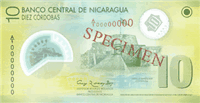 Obverse side of the 10 Nicaraguan córdobas is showing the image of fortress of the Immaculate Conception, Rio San Juan. |
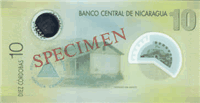 Reverse side of the 10 Nicaraguan córdobas is showing the Hacienda San Jacinto historic in San Benito, Managua. |
| 20 Nicaraguan córdobas | |
|---|---|
| Banknote of 20 Nicaraguan córdobas has dimensions 136×67 mm and main colors are pastel yellow, vanilla, banana mania, light khaki and tan. The banknote of 20 Nicaraguan córdobas was issued on the 15 May 2009. | |
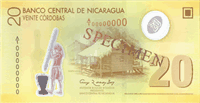 Obverse side of the 20 Nicaraguan córdobas is showing the typical homes on the Caribbean coast of Nicaragua and a Woman grinding (pounding) grain. |
 Reverse side of the 20 Nicaraguan córdobas is showing an illustration of the Palo de Mayo dance. |
| 50 Nicaraguan córdobas | |
|---|---|
| Banknote of 50 Nicaraguan córdobas has dimensions 141×67 mm and main colors are light mauve, plum, thistle, languid lavender, pastel blue, pale aqua and piggy pink. The banknote of 50 Nicaraguan córdobas was issued on the 3 December 2009. | |
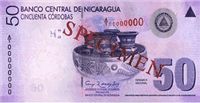 Obverse side of the 50 Nicaraguan córdobas is showing the national ceramic of Nicaragua. |
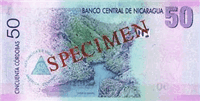 Reverse side of the 50 Nicaraguan córdobas is showing the Canyon of Somoto. |
| 100 Nicaraguan córdobas | |
|---|---|
| Banknote of 100 Nicaraguan córdobas has dimensions 146×67 mm and main colors are pale aqua, light gray, gainsboro, dark chestnut, light slate gray and isabelline. The banknote of 100 Nicaraguan córdobas was issued on the 1 June 2009. | |
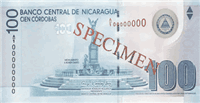 Obverse side of the 100 Nicaraguan córdobas is showing Monument to poet Rubén Darío (Félix Rubén García Sarmiento) (18 January 1867 – 6 February 1916) in Managua and the Logo of the Central Bank. |
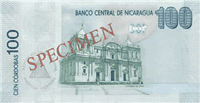 Reverse side of the 100 Nicaraguan córdobas is showing the Cathedral of León where Rubén Darío is buried. |
| 200 Nicaraguan córdobas | |
|---|---|
| Banknote of 200 Nicaraguan córdobas has dimensions 151×67 mm and main colors are lemon chiffon, blond, pale silver, tan, desert sand, timberwolf and pastel gray. The banknote of 200 Nicaraguan córdobas was issued on the 1 June 2009. | |
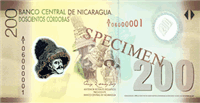 Obverse side of the 200 Nicaraguan córdobas is showing folk dancers and the folk dances. |
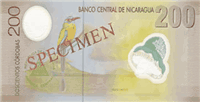 Reverse side of the 200 Nicaraguan córdobas is showing the Guardabarranco bird, the Turquoise-browed Motmot (Eumomota superciliosa) and Isla de Ometepe in the Lake Nicaragua. |
| 500 Nicaraguan córdobas | |
|---|---|
| Banknote of 500 Nicaraguan córdobas has dimensions 156×67 mm and main colors are brick red, candy pink, rose vale, salmon, pale gold, peach, apricot and tea rose. The banknote of 500 Nicaraguan córdobas was issued on the 12 January 2010. | |
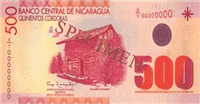 Obverse side of the 500 Nicaraguan córdobas is showing an image of the Residential Museum of Augusto César Sandino. |
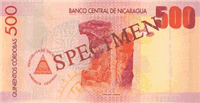 Reverse side of the 500 Nicaraguan córdobas is showing the native statues. |
Useful links
- About Central Bank of Nicaragua:
- Central Bank of Nicaragua
- List of currencies:
- Currencies
- Security and design features of NIO banknotes:
- NIO banknotes
- NIO currency on Wikipedia:
- Nicaraguan córdoba
- Official Website of Central Bank of Nicaragua:
- www.bcn.gob.ni
- Commemorative coins:
- Commemorative Coins